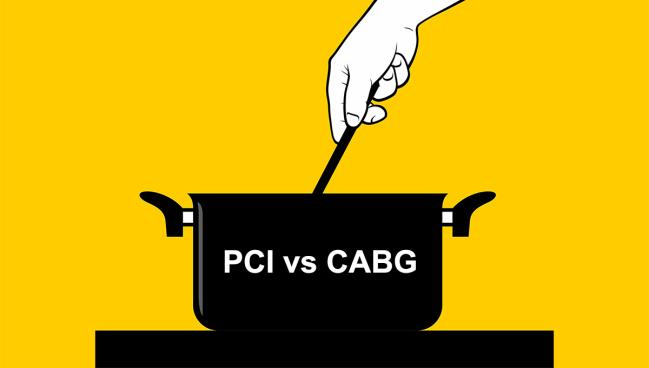Long-term Outcomes With PCI and CABG: More Analyses to Stir the Pot
A new meta-analysis showed no mortality gap between PCI and CABG at 10 years; another takes aim at bifurcation lesions.

Investigators, led by Timothy Woodhead, MBBS (Yorkshire Heart Center, Leeds, England), say the 10-year results should help inform heart team discussions when making decisions about the best revascularization strategy for patients with left main or multivessel CAD.
“Based on the data we have at the moment, there is no statistically significant difference between the two approaches,” senior investigator Heerajnarain Bulluck, MBBS, PhD (Yorkshire Heart Center/University of Leeds), told TCTMD. While the meta-analysis does have limitations, it also provides physicians with some evidence to take back to patients who are candidates for both PCI and CABG. “If the team decides PCI and CABG are equally good for the patient, we have some data to back us and it can help provide some reassurance that there is no mortality difference at 10 years,” said Bulluck.
The rationale for the meta-analysis, he said, stemmed from 10-year follow-up of the SYNTAX Extended Survival (SYNTAXES) study. In that analysis, CABG surgery was associated with better survival compared with PCI in patients with multivessel CAD, but there was no difference in survival between the two strategies in those with left main disease.
Bulluck said they wanted to look at the long-term risk of mortality in available trials of patients with left main and multivessel CAD that had sufficient follow-up to help inform clinical decision-making.
Four RCTs
The meta-analysis, which is based on four randomized, controlled trials with 2,913 patients, was presented last week at EuroPCR 2022 and published simultaneously as a research letter in the American Journal of Cardiology. Included in the analysis are SYNTAXES, PRECOMBAT, LE MANS, and MASS II. Both SYNTAXES and LEMANS used a first-generation DES in the PCI-treated patients, while in LE MANS one-third of patients received a first-generation DES and the rest received BMS. In MASS II, most patients received BMS while one-quarter underwent balloon angioplasty.
In the full cohort, there was no significant difference in survival between PCI and CABG (RR 1.05; 95% CI 0.86-1.28). Similarly, there was no difference in survival when the investigators analyzed trials that included patients with multivessel disease alone (RR 1.16; 0.83-1.63). Nor was there any difference in survival between PCI and CABG in the studies that included those with left main CAD only (RR 0.94; 95% CI 0.78-1.15).
There was a significant amount of heterogeneity between the trials, said Woodhead during the EuroPCR presentation, particularly among studies in patients with multivessel disease without left main CAD (I2 = 66%). Also, investigators did not have any information on the 10-year outcomes of secondary endpoints, such as stroke, repeat revascularization, and MI, and Bulluck acknowledged that the risks of repeat revascularization are known to be higher with PCI than with surgery.
For example, repeat revascularization over 10 years was needed in more than 21% of PCI-treated patients in PRECOMBAT compared with just 10% of those treated with surgery.
On the other hand, “we know from the surgical studies that the risk of stroke is higher in the first 30 days compared with PCI, but after that initial phase the stroke risks are the same,” he said.
“Most patients want to live longer with a good quality of life,” said Bulluck. “Some might accept the initial shorter procedure and recovery time and less risk of stroke and accept that they may come back in 10 years for repeat revascularization.” The positive news is that there are no trade-offs with respect to mortality, he said.
Need For Greater Granularity
Patrick Serruys, MD, PhD (National University of Ireland, Galway), who also presented data from SYNTAXES during the EuroPCR session, praised the investigators for their research, noting that it was unique in that there are limited 10-year data comparing PCI with CABG. However, he stressed that the average treatment effect observed in clinical trials doesn’t include the full spectrum of those with complex CAD seen in practice and to draw practice guidance from these, or from meta-analyses, goes against his “philosophy in medicine.”
“On the one hand, I’m a clinician,” said Serruys. “I see a patient in front of me and all sorts of factors play a role. That’s one extreme. On the other extreme, there’s the meta-analysis. You put all these things together and come to the result—total [risk ratio] 1.05. The poor clinician in the room will go back to his practice and think, ‘I can go with CABG or PCI—they’re equal.’ I don’t think that’s the right way to go.”
Instead, Serruys argued, clinicians need to rely on more information than the present data provide. As the researchers acknowledge, and Serruys pointed out, there is no information on diabetes in this study-level meta-analysis. In the large FREEDOM trial, for example, patients with diabetes and multivessel CAD had a significantly lower risk of death from any cause, nonfatal stroke, and nonfatal MI when treated with CABG surgery.
“We need the granularity,” said Serruys. “We need to personalize [treatment].”
In response, Bulluck agreed with the need to personalize care, but noted the underlining premise is that for patients where the heart team agrees that either surgery or PCI is an option—where there is equipoise—these data provide some reassurances about mortality a decade after the procedures. He also stressed the importance of individualized care based on a discussion with the heart team as well as with the patient.
Alfredo E. Rodriguez, MD, PhD (Centro de Estudios en Cardiología Intervencionista, Buenos Aires, Argentina), one of the discussants following the presentation, noted that while appropriate patient selection is the key point, none of the current devices used in the trials are currently in cath labs today.
Impact of Bifurcation Lesions
Perhaps in search of ‘granularity,’ Serruys, along with lead investigator Kai Ninomiya, MD (National University of Ireland), provided some further information from SYNTAXES during the EuroPCR session, teasing out mortality risks according to presence or absence of bifurcation lesions.
In the analysis, which was published simultaneously in the JACC: Cardiovascular Interventions, Ninomiya showed that patients with one or more bifurcation lesions who received a stent had a significantly higher risk of death at 10 years compared with those without any bifurcations (30.1% vs 19.8%; P < 0.001). In contrast, the presence of bifurcation lesions in patients undergoing surgery had no impact on the long-term risk of death.
Furthermore, investigators showed that the two-stent approach to treating the bifurcation lesion was associated with a higher risk of death at 10 years compared with treating with a single stent only (HR 1.51; 95% CI 1.06-2.14).
Interestingly, the mortality risk associated with the two-stent technique occurred late. At 5 years, there was no difference in mortality, but a landmark analysis showed a significantly higher risk of death with the two-stent technique between 5 and 10 years (23.1% vs 14.5%; P = 0.043).
Maciej Lesiak, MD (Poznan University of Medical Sciences, Poland), who moderated the session, urged caution interpreting results regarding the one- versus two-stent approach in bifurcation lesions, noting that patients were not randomized to these strategies in SYNTAX. Still, it appears that it’s the stent, not the patient’s anatomy, that results in the worse outcome with the second stent.
“If the curves split from the very beginning, I would say OK, the anatomy influences the worse outcomes—patients with the two stents must have worse anatomy or more diffuse disease, more side branch involvement, etc, etc,” said Lesiak. “The fact that there is no difference at 5 years, though, and then it starts to separate many, many years [after PCI], it means it must be the second stent.”
Serruys agreed there’s something to that hypothesis, pointing out that in two-stent strategies like the DK crush bifurcation technique, there’s multiple layers of metal in the vessel.
In an editorial that accompanied the published study, John Bittl, MD (American College of Cardiology, Washington, DC), Jacqueline Tamis-Holland, MD (Mount Sinai Morningside Hospital, New York, NY), and Jennifer Lawson, MD (Johns Hopkins School of Medicine, Baltimore, MD), remind physicians that there is no medical therapy arm in SYNTAX, so the bifurcation analyses can’t answer whether outcomes in these stable patients would have been better with pharmacotherapy alone.
Nonetheless, the findings are important for heart teams. They point out the study should be considered hypothesis-generating only, although it does support CABG as the more strongly favored revascularization strategy in patients with bifurcation lesions, particularly if more than one stent is planned.
Michael O’Riordan is the Managing Editor for TCTMD. He completed his undergraduate degrees at Queen’s University in Kingston, ON, and…
Read Full BioSources
Woodhead T, Matthews CJ, Blaxill JM, et al. Meta-analysis comparing 10-year mortality following percutaneous coronary intervention or coronary artery bypass grafting in left main stem or multivessel coronary artery disease. Am J Cardiol. 2022;Epub ahead of print. May 20, 2022. Paris, France.
Serruys PW, et al. Ten-year survival benefit and appropriateness of CABG or PCI: individual predicted all-cause mortality in patients with complex CAD. Presented at: EuroPCR 2022. May 20, 2022. Paris, France.
Disclosures
- Whitehead and Bulluck report no conflicts of interest.
- Serruys reports consulting for Merillife, Philips, Xeltis, Novartis, and SMT.





Comments